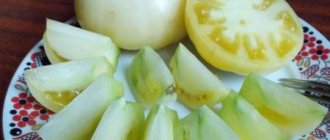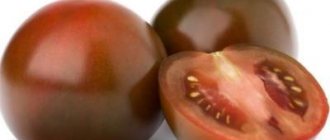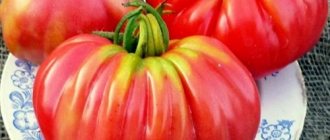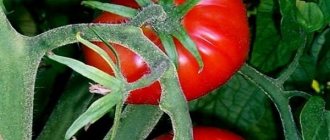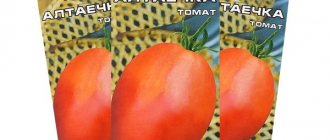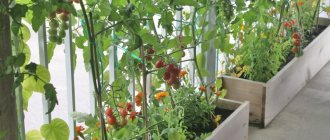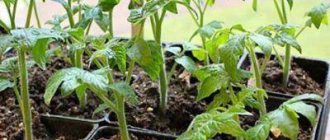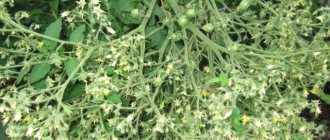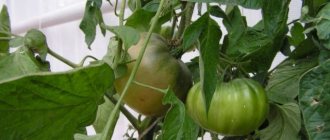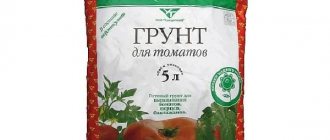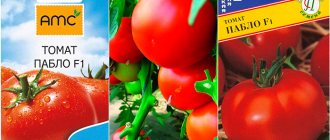Tomato The heat of burning coals is loved by gardeners and farmers. Colorful, juicy tomatoes are delicious in salads and used for a variety of winter preparations.
| Height | Landing location | Ripening time | Fruit color | Fruit size | Origin | Fruit shape |
| Tall | Greenhouse, Open ground | Mid-season | Reds | Large | Variety | Flat-round |
Characteristics of the variety
The characteristics of the “Heat burning coals” variety include:
- high-yielding plant;
- average growing season;
- indeterminate bush;
- excellent fruiting rates in open and protected ground.
The bushes are powerful, the height is from 1.80 to 2 meters. This forces farmers to spend a lot of time staking plants. Maximum attention should be paid to the plant growing in a greenhouse shelter. The garter is carried out by securing the top of the bush under the ceiling structure of the greenhouse. You may need pruning to simply care for your tomato plant and reduce the risk of developing various diseases.
Advice! To increase the yield level, a pair of stems is formed. This is an effective procedure that allows you to get the maximum volume of fruit from each tomato bush.
Firewood
First decide on the menu, and then select firewood for it. Intricate? No! Thoughtful. But among the firewood there are only deciduous ones - only they!
Cherry - for hamburgers, lamb and poultry (especially duck). Alder - for salmon/trout, turkey and chicken. Apple tree - for game, pork, chicken and seafood. Oak - for meat. Maple - for pork, seafood and chicken. Birch - for chicken and any meat.
Do not put conifers in the fire. They are not for barbecues, they are for bards and company.
In any case, firewood for barbecue (large logs) should maintain even heat.
And remember that there is no such thing as too much firewood. Chop and burn them with reserve, since the heat can be reduced, but it cannot be increased.
Lighting up the grill
Tip: if you marinated meat/poultry/fish at home on Friday, and then need to transport the prepared ingredients to the countryside over the weekend, marinate them immediately in ziplock bags (with a zipper). Such bags are sold in supermarkets - for storing or freezing food. They are very easy to pack and transport. If you don’t have time for a long and thoughtful marinade , use the express method: mix soy sauce with lemon juice.
Description of tomatoes
In the description of the fruits of the Zhar variety, burning coals can be distinguished:
- flat-round shape;
- perfectly smooth skin;
- unripe tomatoes are pale green;
- The onset of biological maturity is indicated by the coloring of the fruits red, which is as bright and attractive as possible due to the glossy skin. The color can be so rich that it justifies the name of the variety;
- tomato weight from 250 to 400 grams;
- the flesh is fleshy and juicy.
These are ideal candidates for processing to create delicious sauces. This is facilitated by the absence of a large number of chambers with seed material inside. Tomatoes of the Zhar burning coals variety are of great value for those who like to make tomato juice. Excellent for fresh consumption. The shelf life is low, but the crop copes well with periods of drought.
Farmers who are attentive to the rules of agricultural technology will not have to complain about productivity. The bush produces more than 5 kilograms of tomatoes. Such results, under favorable growth conditions, can be obtained by planting three plants per square meter.
Growing tomatoes in seedlings
It is recommended to sow Zhara seeds in separate boxes with homemade or purchased soil 60 days before the expected time of planting seedlings on permanent soil. In each region, farmers calculate this period depending on climatic conditions.
See also
Description of the hybrid tomato variety Danna, DIY cultivation
Read
Seed material is disinfected in a weak solution of potassium permanganate or hydrogen peroxide. After the seeds are buried 15 mm into the soil, they are watered with warm water from a watering can. When the first shoots appear (after 5-7 days), they are fed with manure or peat. You can use nitrogen fertilizers. Water the seedlings so that the soil does not become waterlogged or dry out.
During the first week, the temperature in the room with seedlings is maintained at +18...+20⁰C, and then increased by 6-7°. Young sprouts require a lot of light, so boxes with seedlings are moved to a lighted place or placed under electric lamps. Daylight should last up to 16 hours, otherwise the seedlings will stretch upward and grow very weakened.
The seedlings are fed with complex mineral mixtures or various growth stimulants. After the development of 2 leaves, the plants dive. They are planted in separate containers to form powerful roots for each seedling. This method allows you to get a plant with a strong stem.
Approximately 9-12 days before transplanting tomatoes onto permanent soil, young bushes are hardened off. Before planting plants in the garden bed, the soil is loosened and manure is added to it. The bush planting scheme is 0.5x0.6 m.
Landing
The plant will take up to 60 days to develop young, strong bushes ready for transplantation. The main influencing factors during planting are:
- temperature;
- soil quality;
- amount of light.
Tomatoes of the Zhar burning coals variety are sensitive to frost at any stage of growth. If the temperature is below 15 degrees, the crop suffers from late seed germination and slow growth. Cold can also affect the ability to set fruit.
Likewise, extreme temperatures over 30 degrees reduce the number of tomatoes and limit their proper development at the seedling stage. The optimal temperature range for tomatoes is from 21 to 28 °C. At higher temperatures, sprouts may not develop or wither.
Tomatoes are sensitive to low light conditions, requiring a minimum of 6 hours of direct sunlight to develop properly. If the intensity of solar radiation is high, the result may be wilting and uneven development of sprouts. For this reason, in greenhouse conditions, it is necessary to choose shaded areas.
Tomatoes can grow well as long as the drainage and physical structure of the soil are at optimal levels. Even at the seedling stage, the quality of the soil plays an important role in the future fate of tomatoes of the Zhar burning coals variety. The plant produces a fibrous root mass that actively consumes nutrients from the soil. The optimal soil pH is from 6.0 to 6.5, but this type of crop develops better in soil with a pH of 5.0-7.5.
Care
- Tomatoes require a constant supply of moisture throughout the growing season. In open ground conditions, tomatoes of the Zhar burning coals variety require up to 5 liters of water per bush weekly. This will be enough for the stable development of the plant and the formation of fruits. In the greenhouse, the bush uses about three liters of water every week.
- Excess water will lead to root rot in anaerobic soil conditions, as well as delayed, less prolific flowering of the bushes and ovary formation. Large amounts of water after fruit formation causes problems with tomatoes. This is expressed in their cracking.
- Flowering also occurs unfavorably in conditions of unstable humidity. Rot in such conditions is a pressing problem.
- A common management practice for tomato crops is to stop irrigating the bushes 2-4 weeks before harvest to maximize fruit dry matter content and minimize soil compaction during harvest.
- Regular application of material with a low nitrogen content, high phosphorus content once a month allows the plant of the Zhar burning coals variety to develop intensively and set tomatoes on time.
- A good way to feed is to apply fish emulsion or seaweed-based fertilizer. This wonderful product will compete with compost and compost tea. They are often used to feed the heat of burning coals.
Fact! An important condition for the full development of the plant is regular loosening, which allows stabilizing air exchange. This has a positive effect on the development of the root system.
Heat-resistant domestic varieties of tomatoes
Indeterminate tomatoes
Variety "Babylon F1"
New mid-season heat-resistant hybrid. A tall bush with medium-sized dark green foliage. Up to 6 ovaries are formed on the hand.
Tomatoes are red, round, weighing up to 180g. When unripe, they have a dark green spot near the stalk.
The variety is resistant to nematodes and pathogenic microflora. The fruits have good transportability.
Variety "Alcazar F1"
One of the best hybrids from. The variety is indeterminate with a powerful root system, thanks to which the top of the stem does not thin out when it is loaded with tomatoes. It has proven itself well when grown in greenhouse conditions. The main method of cultivation is hydroponic, but the variety also bears fruit well when grown in soil.
The variety is mid-early, the growing season is 115 days. The bush belongs to the “vegetative” type with large dark green foliage. The stem grows actively throughout the growing season. The variety tolerates summer heat well. Stably forms ovaries both in winter with a lack of lighting and in hot summer.
Tomatoes are round, uniform in size, weight up to 150 g.
Resistant to tomato cracking and blossom end rot at the genetic level. Resistant to pathogenic microflora.
Variety "Chelbas F1"
One of the best varieties from. A mid-early tomato with a growing season of 115 days. The bush is indeterminate, heavily leafy. Recommended for growing in greenhouses in summer-autumn and for growing in winter-spring.
A cluster usually holds up to 7 tomatoes weighing up to 130 g. The fruits can be stored for up to 40 days, withstanding long-distance transportation.
It forms ovaries well in any conditions, resistance to heat allows this variety to be grown not only in the south of Russia, but also in hotter regions up to Egypt and Iran.
In addition to resistance to pathogenic microflora, the variety is immune to yellow leaf curl. Grows well in root-knot nematode-infested soil. All this allows you to obtain good yields of this hybrid in almost any conditions.
Variety "Fantomas F1"
Indeterminate medium-leaved variety, recommended for cultivation in the Middle Zone in greenhouses. The branching of the bush is average. Medium sized foliage. The height of the bush and the size of the tomatoes are also average. It would be a stable average if it weren’t for the yield (up to 38 kg/m²) and the yield of marketable products amounting to 97%.
Tomato weighing about 114 g. Maximum size 150 g. Spherical, smooth.
The variety is resistant to fungal diseases.
Not all gardeners can install a high greenhouse on their plot for growing indeterminate varieties of tomatoes. In low greenhouses, such varieties, growing up to the ceiling, stop growing and bearing fruit. This problem can be avoided by lowering the stem of an indeterminate tomato.
Determinate tomatoes
Variety "Ramses F1"
Designed for cultivation under film in private farms. . The bush is determinate with a growing season of 110 days.
The tomatoes are round, slightly tapered at the bottom. Dense, red when ripe. The weight of one tomato is 140 g. The ovaries are collected in brushes, of which there are up to 4 on each bush. Productivity up to 13 kg per square meter.
Resistant to pathogenic microorganisms.
Variety "Portland F1"
Mid-early hybrid from "Gavrish", bred in 1995. Determinate bush, up to one and a half meters high. The growing season is 110 days. It is distinguished by high productivity and friendly ripening of tomatoes. Up to 5 kg are harvested from one bush at a planting density of 3 bushes per meter.
The fruits are round, smooth, weighing up to 110 g. Recommended for canned whole fruits and salads.
The variety is distinguished by its ability to form ovaries well under sudden changes in air temperature and high humidity. The stepsons are removed, forming a bush into one stem. Resistant to pathogenic microflora.
Variety "Verlioka plus F1"
High-yielding early ripening hybrid with smooth fruit ripening. A determinate bush can grow up to 180 cm, requiring staking if it grows too tall. Form a bush into one stem. Up to 10 ovaries are formed on the inflorescence racemes.
Tomatoes weighing up to 130 g, round. The purpose of the variety is universal. Thin but dense skin protects tomatoes from cracking.
The variety is resistant to short-term drought and sudden changes in daily temperatures. Resistant to the most common nightshade diseases.
Advice! 2-3 year old seeds are well suited for growing this variety; older ones are not recommended.
Disinfection is not required, but it is recommended to treat the seeds with a growth stimulant 12 hours before sowing.
Variety "Gazpacho"
A mid-late yielding variety from, intended for open beds. Tomatoes take 4 months to ripen. The bush is determinate, medium-covered, up to 40 cm high. The yield is up to 5 kg per unit area.
The tomatoes are elongated, uniform red in color when ripe, weighing up to 80 g. The fruits do not fall off when ripe, being firmly held on the hand.
A variety for universal use. Resistant not only to heat, but also to major fungal diseases and nematodes.
Since the main purpose of the variety is cultivation in open ground, under these conditions the bush is pruned moderately. When grown in a greenhouse, the growth point is transferred to a side shoot that grows under the last brush, forming a bush with one stem. The variety is planted according to a 0.4x0.6 m pattern.
The variety needs regular watering and plenty of sunlight, as well as mineral fertilizers.
Diseases and pests
Aphids, tomato hornworms, maggots, tomato fruitworms and whiteflies can attack tomatoes of this variety. All kinds of preventive methods are used to protect bushes. The most effective is the use of a weak insecticidal soap solution.
Tomatoes are susceptible to viral and fungal diseases, including:
- verticillium;
- fusarium wilt;
- early wilting;
- Septoria leaf spot;
- tobacco mosaic virus;
- rotting after flowering.
To prevent the development of diseases, you need to keep the area clean and free of weeds. Severe diseases can cause tomato plants to suddenly wilt, turn brown, and die in a week or less. Mosaic virus can cause leaves to become misshapen and curled.
